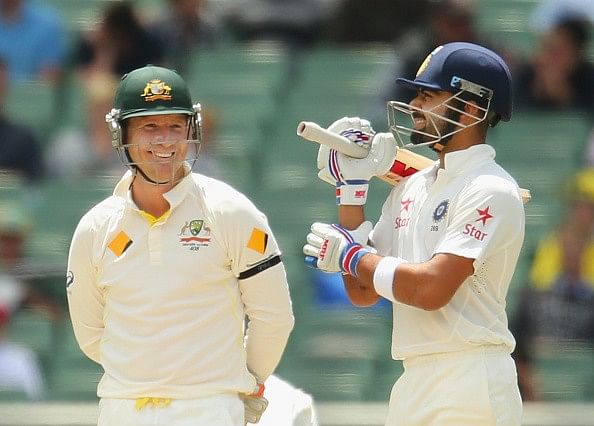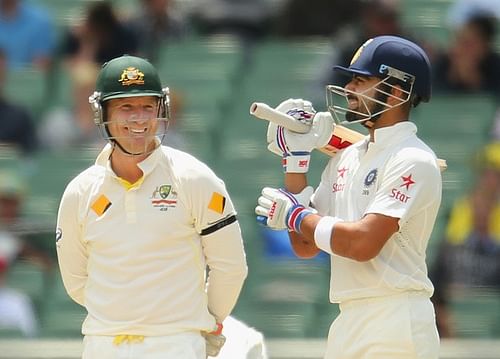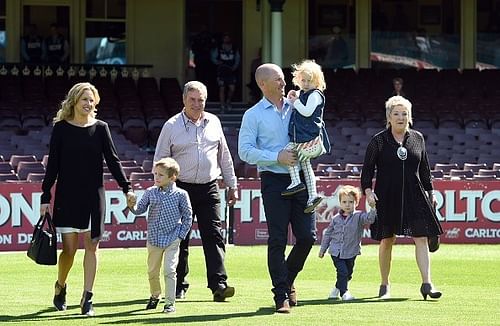
Brad Haddin - The misplaced legacy

It’s the second half of May 2008. Australia are playing a Test match against the West Indies at the Sabina Park in Jamaica. It’s their first one in eight years without Adam Gilchrist. They have handed a debut to his long-time understudy, a man goes by the name Brad Haddin.
During the course of the match, there is a perpetual smile on his face. There had to be, for he had waited so long for this opportunity. He is enjoying every moment he spends on the field.
He doesn’t leave the field even when he breaks his finger while collecting a Mitchell Johnson bouncer. He couldn’t, for he knew how important this opportunity was. At 30, all of them need to be taken.
As the series progresses, a few things about him become apparent. Haddin will do whatever it takes to make his team win. Haddin will smile through it all - taking catches, scoring runs, encouraging his teammates, sledging the opposition, even getting his fingers broken. Playing Test Cricket means a great deal to him, representing his country means a great deal to him.
So, when Haddin announced his retirement a couple of days back, more than seven years after making his debut, this was what his legacy should have been like. That of an ideal team man - the one who never gave up, who did all that was asked of him, who became a perfect mentor for the youngsters, who solidly stood behind his captain at all times, who was, above all, a proud Australian.
But only a few regard this to be Haddin’s legacy. Most disliked him. It’s because this seemingly good guy became Australia’s bad guy when the team required him to be. It’s because this man was brave enough to shed his character for the team. It’s because this man was desperate to do all he could for the team.
29 March 2015, Melbourne. Australia defeat New Zealand to win their fifth World Cup. It should have been a day where the efforts of all the Australian players were acknowledged. It happened with them all, except for Haddin. Playing the villain, he had given many of the New Zealand batsmen aggressive send-offs, and then come out and said that it was because they had been overly nice to Australia.
Haddin shouldn’t have said it, but he did. It irked each and every cricket lover there was. But this was not the real Haddin, it was just him trying too hard to be aggressive, trying too hard to be arrogant, trying too hard to be like the Australia of yore, when they won three successive World Cups from 1999 to 2007.
During the seven year period between his ODI and Test debuts, Haddin was a very likeable fellow. Always brimming with energy, happy to be playing with Gilchrist still around, sharing laughs with the opposition. He wasn’t the villain then. This was who he was. This was the real Bradley James Haddin. Not the man sending off batsmen because they were “too nice” to his team.
Cricketers, like all other humans make certain sacrifices in life. Some get appreciated, some don’t. Some get a lot more love because of it, some not so much. It’s very rare that someone gets hate because of the sacrifices they make for their team. Haddin belongs to this very rare category.
Some cricketers sacrifice their batting positions, some their bowling styles, some their fielding positions. It’s very rare that somebody sacrifices their character. Haddin did. He did it because this team of newbies needed a tough nut to shield them, he did it to carry forward the legacy of Australian cricket. He did it for Australia.
The four days from 8th to 11th July 2015 were Haddin’s last as an Australian player. His last Test, the opening match of the 2015 Ashes, much like his last 12 ones, had been disastrous. He didn’t score any runs, as had been the case for the past 18 months, where he was averaging just 15 in Tests.
More importantly, he dropped Joe Root when he hadn’t even opened his account. Root went on to score what was a match and arguably Ashes winning century. Haddin smiled through it all - the drop, the Root century, the loss, everything. That’s how he always was on the cricket field.
A lot of people wanted Haddin dropped. What irritated the people more was the fact that Haddin was still as talkative as before. Poor form had not affected the villainous character Haddin had been portraying ever since he started playing Test cricket for Australia.
But captain Michael Clarke was fully behind Haddin, in what he had announced would be his last Test series. It was almost certain that he would play all the five matches. He ended up playing only one.
After the first Test, his four-year-old daughter Mia, suffering from a rare form of Cancer, had some complications. He had been beside her when she was first diagnosed in 2012. For more than a year, he didn’t play for Australia to look after his daughter.

This time, she required surgery for what was told to be internal bleeding. Haddin left to be with his family, thus stepping down from selection for the second Test. Peter Nevill replaced him, kept well, scored a well compiled 45 and Australia won.
When Haddin rejoined the squad, he was pushed back to the bench. Australia had dropped him. He never played again. People were happy. His teammates, both former and current, not one bit.
Haddin will always be perceived like this. Those close to him will know how valuable he is. Those who just see what happens on the field think him to be a disrespectful and arrogant man. This is what his legacy is.
When Haddin was asked if he regretted withdrawing from the second Test at Lords, he said “ For me, my family comes first. I don’t have any regrets, they needed me.” This is what Haddin has always done. To do what people always needed him to. This is how Haddin, Australian Baggy Green number 400 should be remembered. The man who became someone he wasn’t for his team, the man who was completely fine with being disliked if it helped his team.
During the press conference he had called to announce his retirement, Haddin was, as usual, all smiles. He was laughing as well. He seemed a lot lighter than before. There were no questions which he shot down, no aggressive retorts to nagging journalists.
There was a sense of calm evident in the way Haddin was speaking. For the first time since he became a Test player, Haddin was his real self in front of the media. He was not portraying himself as that tough, villainous guy anymore. For, he wasn’t. Unfortunately, that’s how many of us will remember him.